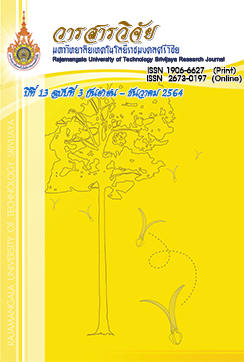Potential of Vermicompost Produced from Local Orchid Waste
Keywords:
vermicomposting, organic fertilizer, earthworm, orchidAbstract
The aim of this research was to determine the feasibility of digesting orchid flower-containing substrate, which is community waste by Eudrilus eugeniae. The Completely Randomized Design (CRD) was used with 4 treatments and 3 replications. The treatments consisted of: 1) control (cow dung: coconut coir fiber at the ratio of 2:1), 2) cow dung: orchid flower at the ratio of 2:1, 3) cow dung: coconut coir fiber: orchid flower at the ratio of 2: 0.5: 0.5 and 4) cow dung: coconut coir fiber: orchid flower at the ratio of 2:1:0.5. The experiment was conducted for 50 days, and the results showed that treatment 2 contained the highest total nitrogen, phosphorus, pH and electrical conductivity (EC) (2.10%, 0.89%, 6.82 and 4.65 (dS/m), respectively) (p < 0.05). Treatment 4 gave the highest total potassium (0.98%) (p < 0.05), while treatment 3 gave the highest organic carbon (OC) and organic matter (OM) with the percentage significance (p < 0.05) for 24.56 and 42.24%, respectively and the average of C:N ratio was not difference (p < 0.05). Treatment 1 gave the highest product of vermicompost than other groups (p < 0.05). Moreover, E. coli and Salmonella spp. did not appear in the vermicompost from all treatment. From all results, it showed that the orchid flower could be used as bedding material to feed earthworms with the suitable ratio of cow dung: coconut coir fiber: orchid flower at 2:1:0.5.
References
Ackers, M.L., Mohan, B.E., Leahy, E., Goode, B., Damrow, T., Hayo, P.S., Bibb, W.F., Rice, D.H., Barrett, T.J., Hutwagner, L., Grin, P.M. and Slutsker, L. 1998. An outbreak of Escherichia coli O157:H7 infections associated with leaf lettuce consumption. Journal infectious diseases 177: 1588-1593.
Chitrepriya, K., Asokan, S. and Nagarajan, R. 2013. Estimating the level of phosphate solubilizing bacteria and Azotobacter in the vermicompost of Eudrilus eugeniae and Perionyx excavates with various combinations of cow -dung and saw-dust. International Journal Scientific Research Publications 3: 1-6.
Chupong, S., Boonlertnirun, K. and Tangsombatvichit, P. 2016. The study of the potential of vermicomposting produced from eater hyacinth (Eichhornia crassipes) in the canal of Ayutthaya province, pp. 519-524. In The 1st National Academic Conference. Rajamangala University of Technology Suvarnabhumi, Ayutthaya. (in Thai)
Cieslak, P.R., Barrett, T.J. and Green, T.M. 1993. Escherichia coli O157:H7 infection from a manured garden. Lancet 7: 342-367.
DaDong, S. 2006. Anatomy and Treatment of Dry Sludge from Kasetsart University Dairy Center by Eudrilus Eugenia. Master of Science (Zoology), Kasetsart University. (in Thai)
Department of Agriculture. 2005. Manual of organic fertilizer. (Academic edition). The Agricultural Cooperative Assembly of Thailand, Bangkok. (in Thai)
Dominguez, J. and Edwards, C.A. 2004. Vermicomposting organic wastes: A review, pp. 369-395. In Shakir Hanna, S.H., Mikhail, W.Z.A., eds. Soil zoology for sustainable development in the 21st century. Cairo.
Edwards, C.A. and Burrows, I. 1988. The potential of earthworm compost as plant growth media, pp. 211-220. In Edwards, C.A., Neuhauser, S.P.B., eds. Earthworms in Environmental and Waste Management. Academic Publishing, Netherlands.
Edwards, C.A., Aracon, N.Q. and Sherman, R. 2011. Vermiculture technology: Earthworms, organic wastes and environmental management. Taylor and Francis Journals 335-348.
Faculty of Soil Science. 1987. Primary Soil Science Department of Soil Science. Kasetsart University Press, Bangkok. (in Thai)
Faculty of Soil Science. 1998. Basic Soil Science. 8thed. Kasetsart University Press, Bangkok. (in Thai)
Garg, P., Gupta, A. and Satya, S. 2006. Vermicomposting of different types of waste using Eisenia foetida: Acomparative study. Bioresource Techology 97: 391-395.
Kanchanakun, S. 2011. Roi Phan, Preuksa, Orchid. Setthasilp, Bangkok. (in Thai)
Khwairakpam, M. and Bhargava, R. 2009. Vermitechnology for sewage sludge recycling. Journal Hazard Mater 161(2-3): 948-954.
Konyong, P. 2009. Adoption on Orchid Marketing Standard for Exportatuon: A Case Study of Orchid Cultivatiors in Nong Nok Kai Subdistrict Areas, Krathum Baen Distric, Samut Sakhon Province. Master of Science (Agricultural Research and Development), Kasetsart University.
Ndegwa, P.M. and Thompson, S.A. 2000. Effect of C-to-N ratio on vermicomposting of biosolid. Bioresource Technology 75(1): 7-12.
Panpuang, N., Chuntranuluck, S. and Chaowanapong, P. 2014. The study and development of vermicomposting production by Eurilus eugeniae., pp. 385-392. In The 52 nd Kasetsart University Annal Conference: Science, Natural Resources and Environment. Kasetsart University, Bankok. (in Thai)
Parthasarathi, K., Ranganathan, L.S., Anandi, V. and Zeyer, J. 2007. Diversity of microflora in the gut and casts of tropical composting earthworms reared on different substrates. Journal Environmental Biology 28(1): 87-97.
Prasopsuk, J. and Iwai, C.B. 2013. Monitoring of pesticide residues in compost, vermicompost and biological fermentation from organic waste. Science and Techology Journal Maha Sarakham University 32(2): 154-160.
Schirmer, W.N., Juca, J.F.T., Schuler, A.R.P., Holanda, S. and Jesus, L.L. 2014. Methane production in anaerobic digestion of organic waste from Recife (Brazil) landfill: evalution in refuse of different ages. Brazillian Journal of Chemical Enginering 31: 373-384.
Sirithanakkorn, P., Pharam, K. and Sanusan, S. 2014. Different of bedding on growthworms and vermicompost production. Khon Kaen Agriculture Journal 42(Suppl.1): 714-721. (in Thai)
Steven, J.F., Angela, Y.Y.K, Chris van, K., Paul, F.H. and Johan, S. 2007. Influence of earth worm activity on aggregate-associated carbon and nitrogen Dynamics differs with agroecosystem management. Soil Biology and Biochemistry 39(1): 1014-1022.
Tangsombatvichit, P. and Ketrot, D. 2018. The quality of vermicompost from sweet potato crop wastes and its impact on growth promotion of Brassica chinensis. RMUTSB Academic Journal 6(2): 124-133. (in Thai)
Wichaiwit, W., Satjaphan, K. and Rotsopha, B. 2012. Qualities of vermicompost of different types of waste using Perionyx excavates. King Mongkut’s Agricultural Journal 30(2): 86-96. (in Thai)
Downloads
Published
How to Cite
Issue
Section
License
The content and information in the article published in Journal of Rajamangala University of Technology Srivijaya It is the opinion and responsibility of the author of the article. The editorial journals do not need to agree. Or share any responsibility.







